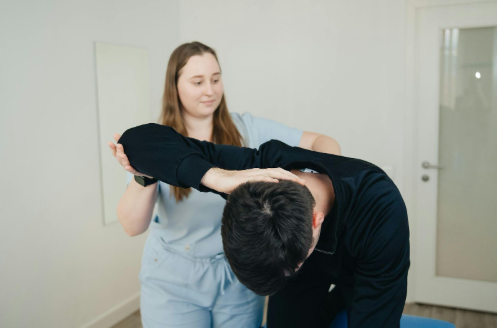Summer Travel and Spinal Health: How to Avoid Back Pain on Road Trips and Flights
Summer Travel and Spinal Health: How to Avoid Back Pain on Road Trips and Flights

Summer is the perfect season to pack your bags and hit the road or board a plane for some much-needed relaxation. But while vacations are great for the soul, they can sometimes be rough on your back. From cramped airplane seats to long hours behind the wheel, travel puts your spine through situations it's not used to.
With a little preparation, though, you can keep your back feeling good the whole trip.
How and Why Travel Affects Your Spine
When you travel, your spine faces several stressors that can lead to discomfort or pain. Sitting for long stretches reduces blood flow, which makes your muscles stiff and sore. Limited movement also puts pressure on your lower back, especially if you slouch or use poor posture. Whether you’re behind the wheel or stuck in a plane seat, staying still for too long is one of the main reasons back pain flares up during travel.
Another issue is the change in routine. Your usual movement patterns are disrupted, and unfamiliar beds or pillows in hotels or rentals may not support your spine the way your own bed does. Even carrying luggage incorrectly can lead to muscle strain. All of these changes add up, making it easier for spinal discomfort to sneak in.
Get Comfortable Before You Hit the Road
If you’re driving, start by adjusting your seat so your back is fully supported. Sit upright with your knees at hip level and your feet flat on the floor. Use a small pillow or rolled-up towel behind your lower back if your car doesn’t have good lumbar support. Make sure you are close enough to the steering wheel to avoid overreaching, while at the same time, you are not so close that your elbows are locked.
For plane travel, the seating situation can be more challenging. Most airplane seats lack proper lumbar support, so bringing a small cushion or travel pillow can make a big difference. Sit all the way back in your seat with your spine in alignment and avoid slouching or leaning to one side. If possible, recline the seat slightly to reduce pressure on your lower back.
Take Regular Breaks to Move
Staying in the same position for hours at a time is tough on your spine. If you’re on a road trip, plan to stop every hour or two to get out of the car, walk around, and stretch. Even five to ten minutes of movement helps to keep your muscles loose and your circulation flowing.
On flights, it can be harder to get up and walk, especially if you’re in the middle seat. Still, it’s important to move when you can. Stand up and stretch during longer flights, and try doing small in-seat stretches, such as rolling your shoulders or gently twisting your torso. Even tapping your feet or shifting your weight in your seat helps activate your muscles.
Pack Smart to Protect Your Back
Heavy or awkward luggage can strain your spine, especially if you're lifting or carrying it the wrong way. Choose luggage with wheels and a telescoping handle to avoid having to carry bags for long distances. When lifting a suitcase into a car trunk or an overhead bin, bend at the knees and use your legs to lift.
Remember that a single large bag is usually harder on your body than spreading items across two smaller ones. Try to pack light and avoid overstuffing. If you're wearing a backpack, make sure both shoulder straps are on and adjusted evenly so the weight is distributed properly.
Stretch and Strengthen Before You Travel
Taking the time to stretch and strengthen your core before a trip can pay off in a big way. Gentle yoga or daily stretching routines help keep your muscles relaxed and your joints mobile. Focus on your lower back, hips, and hamstrings, as these areas are most affected by prolonged sitting.
Core strength also plays a role in spinal health. Exercises like planks, bridges, or bird-dogs help support your lower back and improve posture. You don’t have to do an intense workout, but keeping your body strong and flexible helps protect your spine no matter where your travels take you.
Sleep Smarter While Away from Home
Hotel beds can be a gamble. Some are too soft, others too firm, and none of them are your own. If you find yourself in an uncomfortable bed, try placing a pillow under your knees if you’re sleeping on your back or between your knees if you’re on your side. This can help keep your spine in a more neutral position. Neck support is just as important as back support. If the hotel pillow feels too high or too flat, try folding a towel into the shape and height that feels best for you.
Support Your Body After Travel Ends
Once you’ve reached your destination or returned home, take a little time to reset your body. Light stretching, gentle walks, or a warm shower can ease any tension you picked up along the way. If you experience lingering discomfort, it may be a sign that your spine needs some extra attention.
Chiropractic care is a great way to restore alignment and mobility after travel. Even if you don’t have any major pain, a post-trip adjustment can help reduce tightness, improve your range of motion, and prevent small issues from turning into bigger problems. Your spine works hard during travel, so giving it some care afterward helps keep you feeling your best.
If your summer plans include a long drive or flight, or if you’re already feeling stiff from a recent trip, our team at
Sycamore Integrative Health Center can help.
Contact us today to schedule your appointment and keep your spine ready for every adventure!









